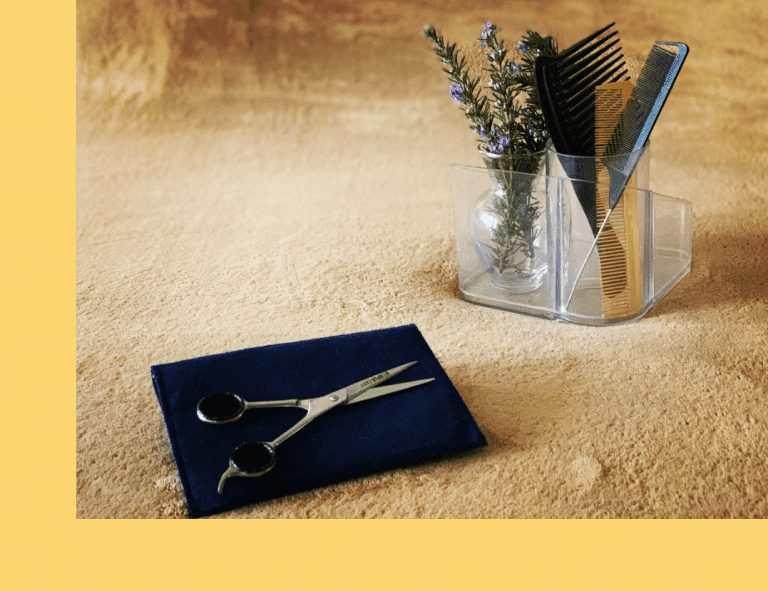The Key to Achieving Fullness and Length
The first time you decide to trim your textured hair can be scary, especially because you want to retain as much fullness and length as you can. Cutting off hair that we have spent nurturing and meticulously grooming can seem counter-intuitive, which is why a lot of us can go months and even years without getting a trim. But what if trimming is the key to achieving health and growth?
Trimming your hair gets rid of wispy thin ends which, if left untrimmed, will continue to split up your hair shaft thinning out your hair. Trimming also gets rid of single strand knots which give hair a frazzled appearance and contribute to further detangling and breakage. If you struggle with bushy ends and stunted growth, your hair might be due for a little trim.
Before we delve further into trimming hair, it’s very important to know that you should only cut your hair with professional shears. Cutting with scissors that are used for other purposes will leave your hair with jagged ends, causing your hair to split.
You can find one at your local beauty supply store, or get this great and affordable one here. Once you purchase your shears, make sure they aren’t used for any other purpose.

How do I know it’s Time to Trim?
Most of us are too focused on growth that we may overlook our bad ends. If you are not sure whether it’s time for a trim or not, simply run a thin comb through a small section of your hair after thoroughly detangling it. When the comb stops to move or moves much slowly, it’s an indication that the ends need to be removed.
Another indicator is when our ends become bushy and dry, or tend to taper when worn out or braided. If you are not sure, use this simple yet effective hack: take a small piece of white paper and lay a strand of hair against it. Look closely at your hair. The split and knotted ends stand out against a white background and are easy to spot. Watch the video below to learn how to check the ends of your hair.
How Often Should I Trim My Hair?
Our hair grows ½ inch monthly or 6 inches in a year on average. Trimming ½ inch of your hair every 3 – 4 months will leave you with enough length for noticeable growth, unless of course you decide to get a specific style, which would mean cutting more inches. If you notice dry, split ends, do not wait for your next trim date, get rid of them sooner. Holding on to ends that are damaged will only undermine your efforts to grow healthy hair.
If you wear your hair in protective styles most of the time and diligently moisturize your ends, you may find that you can go for longer than 3 – 4 months for a trim. Regularly assess your hair ends to determine if a trim is needed. If you are unsure of what frequency is best for me, our platform can help! Simply answer a few questions, access your personalized hair page and learn how often your unique hair needs a trim.
What are the Different Ways I Can Trim my Hair?
There are several ways to trim hair at home. We will look at two methods, and look at the pros and cons of cutting hair wet versus dry.
Search and Destroy
As the name implies, you can let your hair down, detangle it, and search thoroughly for single strand knots and split ends, cutting of only the ends that are damaged. Trimming natural hair ends this way is effective but will leave you with slightly uneven lengths and it can be time consuming.
Dusting
If you’re looking to retain length while trimming natural hair ends, dusting is the perfect option. Take small sections of hair into your hands and remove just the very ends, as little as possible. This will keep your hair healthy while retaining length.
Should I Trim My Hair Wet or Dry?
Whether you cut your hair wet or dry will depend on several factors. Consider each option depending on your hair and your goals.
Cutting Hair Wet
Cutting textured hair wet has its pros and cons. Wetting our hair stretches our hair out and gives us more control over our trim, making the trimming process easier and possibly quicker. The down side is, when our hair is wet, it’s at its weakest. Weak hair is prone to damage.
Moreover, if we have different textures throughout our hair, such as tighter curls on one side of our hair, cutting hair while wet and stretched out may result in uneven lengths once hair has dried and returned to its natural curl state.

Cutting Hair Dry
The main idea behind cutting hair when it’s dry is that we wear our hair dry, so we can easily get the best angle for our faces. However, if you’re trying to trim natural black hair for the first time, you’ll want to take your time with this. Budget enough time and don’t rush through it.
Cutting Dry and Stretched
The idea behind this method is to easily spot split and damaged ends while maintaining the shape of our hair. Straighten your hair by blow drying it (cold air preferred!). You can also stretch the hair by using the banding method or doing twists or braids prior to trimming. Take each section and comb it through, first with a wide-tooth comb followed by a fine tooth comb. This allows you to see the damaged ends clearly, because they will be frazzled and a fine tooth comb will have a hard time passing through. You will then cut across to remove the damaged ends. This method is ideal if you wear your hair in twists or braids because you may end up with slightly different lengths across the head.
Cutting Dry and Curly
Cutting your hair dry and curly will require you to take each clump of curls and trim the damaged and knotted ends. While this method ensures you keep your hair’s shape intact, it will take time to get through the entire head especially if you have tighter curls.
Take the Step
Trimming natural hair for hair growth might sound counterproductive, but it is necessary and effective. When you decide to trim natural black hair for the first time, it can be scary, but we hope with these methods you will take the bold step of trimming yours soon. As with all things natural hair, the more you practice, the better you will be at it. So, take the first step and let us know how it goes!
Disclosure: Some of the links are affiliate links. This means that at no additional cost to you, www.Glisen.me will earn a commission if you go through and make a purchase.

